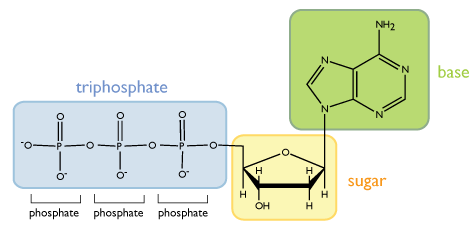

- #DNA SUGAR PHOSPHATE BACKBONE COVALENT BOND PDF#
- #DNA SUGAR PHOSPHATE BACKBONE COVALENT BOND FULL#
- #DNA SUGAR PHOSPHATE BACKBONE COVALENT BOND SOFTWARE#
We now need a quick look at the four bases. What we have produced is known as a nucleotide. These bases attach in place of the -OH group on the 1' carbon atom in the sugar ring. This isn't particularly relevant to their function in DNA, but they are always referred to as bases anyway. They have lone pairs on nitrogens and so can act as electron pair donors (or accept hydrogen ions, if you prefer the simpler definition). Note: These are called "bases" because that is exactly what they are in chemical terms.

In DNA, these bases are cytosine (C), thymine (T), adenine (A) and guanine (G). The final piece that we need to add to this structure before we can build a DNA strand is one of four complicated organic bases. We are soon going to simplify all this down anyway! The version I am using is fine for chemistry purposes, and will make it easy to see how the DNA backbone is put together. You may find a hydrogen attached instead of having a negative charge on one of the oxygens, or the hydrogen removed from the top -OH group to leave a negative ion there as well. Note: You may find other versions of this with varying degrees of ionisation. A phosphate group is attached to the sugar molecule in place of the -OH group on the 5' carbon. The other repeating part of the DNA backbone is a phosphate group. You read 3' or 5' as "3-prime" or "5-prime". The carbons in the sugars are given the little dashes so that they can be distinguished from any numbers given to atoms in the other rings. If you just had ribose or deoxyribose on its own, that wouldn't be necessary, but in DNA and RNA these sugars are attached to other ring compounds. You will notice that each of the numbers has a small dash by it - 3' or 5', for example. The carbon atom to the right of the oxygen as we have drawn the ring is given the number 1, and then you work around to the carbon on the CH 2OH side group which is number 5. The only other thing you need to know about deoxyribose (or ribose, for that matter) is how the carbon atoms in the ring are numbered. Deoxyribose, as the name might suggest, is ribose which has lost an oxygen atom - "de-oxy". In other words, you are looking at the molecule from a bit above the plane of the ring. The heavier lines are coming out of the screen or paper towards you. Each of the four corners where there isn't an atom shown has a carbon atom. This diagram misses out the carbon atoms in the ring for clarity. Ribose is the sugar in the backbone of RNA, ribonucleic acid. I'm going to give you the structure of that first, because you will need it later anyway.
#DNA SUGAR PHOSPHATE BACKBONE COVALENT BOND FULL#
The full name of DNA, deoxyribonucleic acid, gives you the name of the sugar present - deoxyribose.ĭeoxyribose is a modified form of another sugar called ribose. The backbone of DNA is based on a repeated pattern of a sugar group and a phosphate group.
#DNA SUGAR PHOSPHATE BACKBONE COVALENT BOND SOFTWARE#
Normally I prefer to draw my own diagrams, but my drawing software isn't sophisticated enough to produce convincing twisted "ribbons". You can see it in its original context by following this link if you are interested. Note: This diagram comes from the US National Library of Medicine. The diagram shows a tiny bit of a DNA double helix. I'm going to start with a diagram of the whole structure, and then take it apart to see how it all fits together. Most will also have heard of the famous double helix. These days, most people know about DNA as a complex molecule which carries the genetic code. The booklet is written for A level biology students, and goes into far more detail than you will need for chemistry purposes.Ī quick look at the whole structure of DNA
#DNA SUGAR PHOSPHATE BACKBONE COVALENT BOND PDF#
Note: If you are doing biology or biochemistry and are interested in more detail you can download a very useful pdf file about DNA from the Biochemical Society.Ĭhemistry students at UK A level (or its various equivalents) should not waste time on this. If you are interested in this from a biological or biochemical point of view, you may find these pages a useful introduction before you get more information somewhere else.

This material is aimed at 16 - 18 year old chemistry students. This page, looking at the structure of DNA, is the first in a sequence of pages leading on to how DNA replicates (makes copies of) itself, and then to how information stored in DNA is used to make protein molecules.


 0 kommentar(er)
0 kommentar(er)
